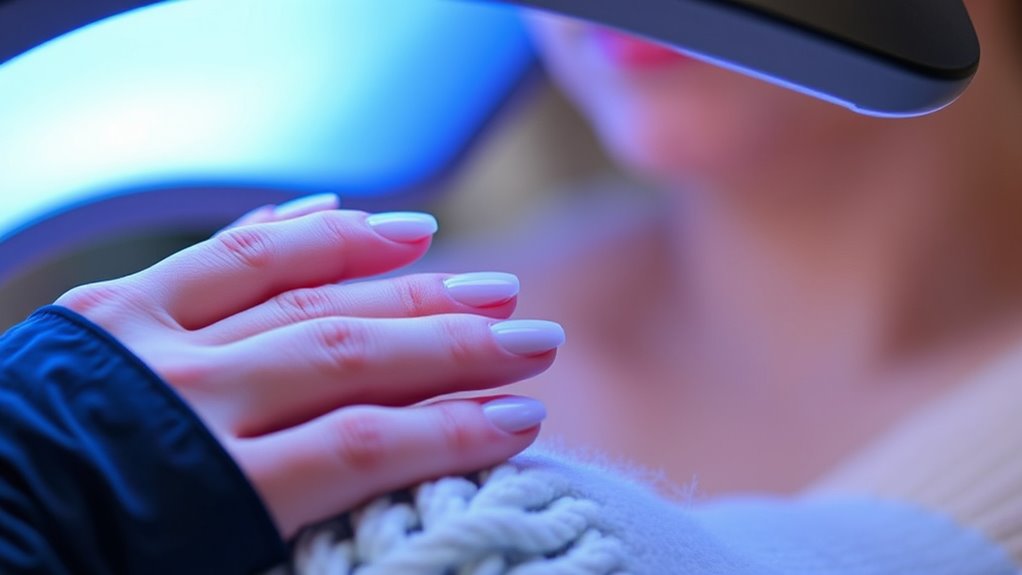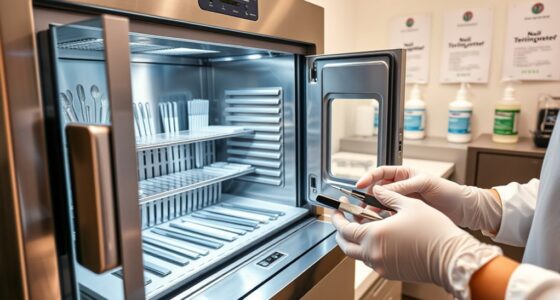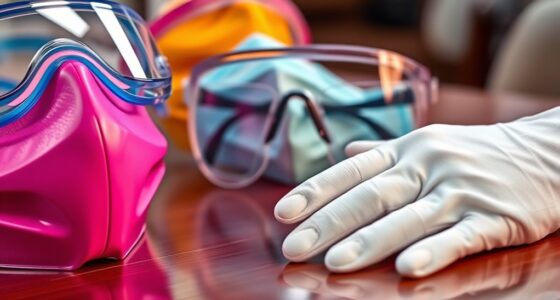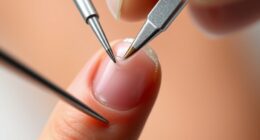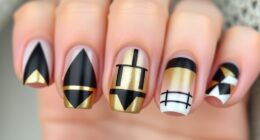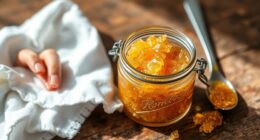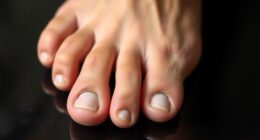To protect your skin during gel manicures with UV lamps, always look for devices with safety features like timers, motion sensors, and protective shields. Wear UV-protective gloves or apply broad-spectrum sunscreen on your hands, and limit your exposure time based on manufacturer guidelines. Regularly check that your equipment is in good condition. Staying aware of potential risks and using these safety steps helps prevent skin damage over time—discover more ways to stay safe with proper UV lamp use.
Key Takeaways
- Use UV protective gloves that shield hands while leaving fingertips exposed during curing.
- Apply broad-spectrum sunscreen on hands before gel application for added UV protection.
- Choose UV lamps with safety features like timers, motion sensors, and protective shields.
- Limit exposure time by following manufacturer-recommended curing durations and avoid overuse.
- Regularly inspect and maintain the UV lamp to ensure safety features are functional and reduce UV emission risks.
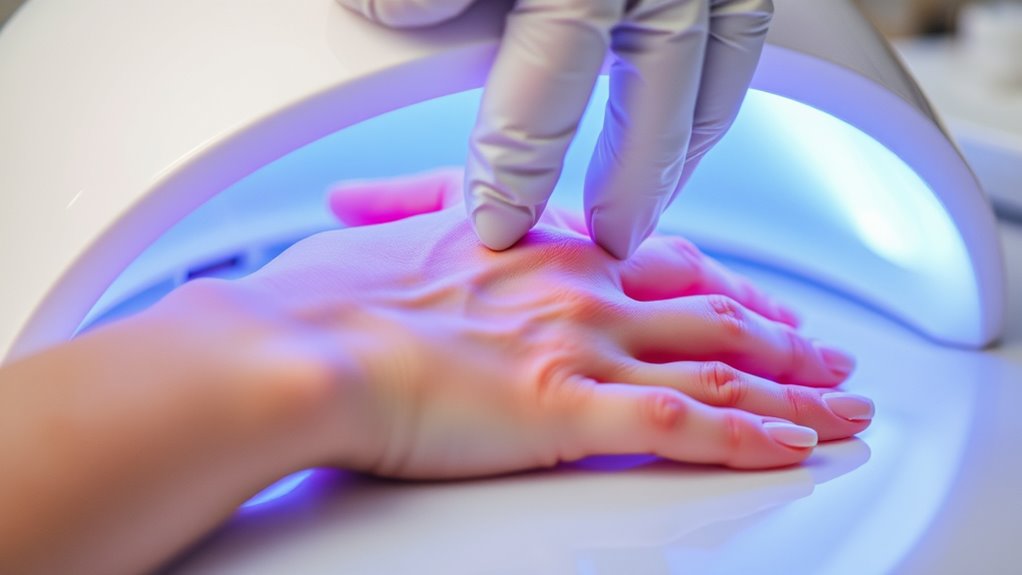
While UV lamps are effective for sterilization and disinfection, they can pose serious health risks if not used properly. When it comes to gel manicures, understanding UV exposure and lamp safety features is vital to protecting your skin. UV lamps emit ultraviolet light that can cause skin damage over time, especially if you’re exposed repeatedly or for extended periods. It’s essential to be aware of how these lamps work and the safety measures you should take to minimize risks.
First, always pay attention to the lamp safety features built into your UV device. Many modern lamps include safety mechanisms like automatic shut-off timers, motion sensors, or protective shields that help limit unnecessary exposure. These features are designed to turn off the lamp once your curing session is complete, preventing you from lingering under UV light longer than needed. When selecting a UV lamp, opt for one that has these safety features, as they add an extra layer of protection. Additionally, check if the lamp has a timer control, which guarantees you only expose your skin for the ideal curing time, reducing the chance of overexposure.
Knowing the importance of UV exposure is key. Even brief, repeated exposure can increase your risk of premature skin aging and, over time, potentially lead to skin cancer. To protect yourself, wear UV protective gloves that leave only your fingertips exposed during curing. These gloves serve as a barrier, considerably reducing UV exposure to your skin. Applying broad-spectrum sunscreen on your hands before your manicure can also help minimize UV damage, especially if you’re doing regular gel nails. Remember, protecting your skin isn’t just about avoiding immediate discomfort but also about safeguarding your health in the long run. Moreover, being aware of UV exposure limits can help you manage your overall risk more effectively.
Furthermore, follow the manufacturer’s instructions for your specific UV lamp. Proper use includes not only adhering to recommended curing times but also ensuring the lamp is in good working condition. Damaged or malfunctioning lamps may emit higher levels of UV radiation or fail to turn off automatically, increasing your risk. Regularly inspect your equipment, replace bulbs when needed, and never bypass safety features. If your lamp doesn’t have built-in safety features, consider adding external protections like UV shields or using shorter curing times.
Frequently Asked Questions
Are There Specific UV Lamp Brands That Are Safer?
When considering UV lamp safety, you might wonder if certain UV lamp brands are safer. While some brands claim to emit less UV radiation, there’s no definitive evidence that any brand is completely risk-free. To protect your skin, focus on using lamps with built-in UV protection, follow recommended exposure times, and wear protective gloves. Always prioritize safety over brand names, and consult professional advice for the best options.
How Often Should I Replace My UV Lamp?
You might think your UV lamp lasts forever, but its lifespan actually influences how often you should replace it. Typically, the replacement frequency depends on the lamp’s quality and usage, usually around 300-500 hours of use. Don’t wait until it stops curing your gel; replace it proactively to ensure effective curing and protect your skin. Regularly check the lamp’s performance—if it’s dim or uneven, it’s time for a new one.
Can I Use Natural Sunlight for Curing Gel Nails?
You might wonder if natural sunlight can replace a UV lamp for curing gel nails. While sunlight is natural, it isn’t reliable for curing effectiveness because it varies in intensity and UV exposure. Sunlight may take longer and might not fully cure the gel, risking chipping or smudging. For consistent results and proper curing, it’s best to stick with a dedicated UV or LED lamp rather than relying on natural sunlight.
Are There Age Restrictions for UV Gel Manicures?
Age allowances and awareness affect UV gel manicures. While there aren’t strict age restrictions, safety concerns rise with younger clients, especially children and teens. You should consider caution, consulting professionals, and avoiding unnecessary UV exposure. For minors, parental permission is wise, and limiting sessions helps prevent potential skin damage. Remember, protecting your skin’s safety is essential, regardless of age, so stay informed and prioritize precaution during UV gel manicures.
Do UV Lamps Emit Harmful Radiation Beyond UV Rays?
You might wonder if UV lamps emit harmful radiation beyond UV rays. The UV wavelength they produce is primarily UVA, which can penetrate the skin. While occasional use is generally safe, prolonged exposure increases the risk of skin damage. To guarantee skin protection, limit your exposure time, wear UV-protective gloves, and apply broad-spectrum sunscreen on your hands. Always follow safety guidelines to minimize any potential health risks.
Conclusion
To keep your skin safe, always follow recommended UV lamp guidelines like wearing gloves or applying broad-spectrum sunscreen. Think of it as shielding your skin like a knight in shining armor—you’ll enjoy gorgeous gel nails without risking your health. Remember, a little caution goes a long way in protecting you from UV damage. So, stay vigilant and prioritize your skin’s safety—beautiful nails are great, but healthy skin is priceless.
